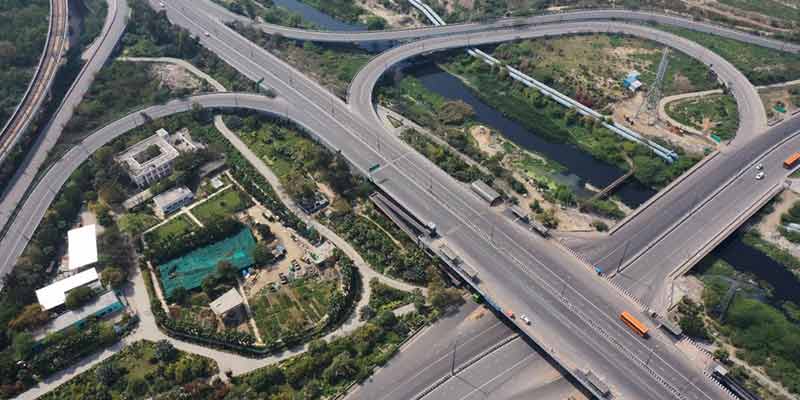- India
- Apr 08
Explainer / Bharatmala Pariyojana
The National Highways Authority of India (NHAI) has achieved a record 3,979 km of highways construction in the financial year 2019-20, an official said.
The feat was achieved on the back of ambitious highways development programmes like Bharatmala Pariyojana.
The construction pace has seen a steady growth with 3,380 km construction in the FY 2018-19, the official said.
What is NHAI?
National Highways Authority of India (NHAI) was set up by an Act of the Parliament in 1988. It has been entrusted with the National Highways Development Project (NHDP), which along with other minor projects for development, maintenance and management.
Its main objective is to ensure that all contract awards and procurements conform to the best industry practices with regard to transparency of process, adoption of bid criteria to ensure healthy competition in award of contracts, implementation of projects conform to best quality requirements and the highway system is maintained to ensure best user comfort and convenience.
What is the significance of NHAI?
NHAI is mandated to implement National Highways Development Project (NHDP) which is India’s largest ever highways project in a phased manner. Currently, the National Highways have a total length of 1,32,499 km to serve as the arterial network of the country. Although National Highways constitute only about 2 per cent of the road network, it carries 40 per cent of the total road traffic.
Rapid expansion of passenger and freight traffic makes it imperative to improve the road network in the country. Accordingly, the government launched major initiatives to upgrade and strengthen National Highways through various phases of NHDP.
Functions of NHAI
* To develop, maintain and manage National Highways vested in it by the government.
* To collect fees on National Highways, regulate and control the plying of vehicles on National Highways for its proper management.
* To develop and provide consultancy and construction services in India and abroad and carry on research activities in relation to the development, maintenance and management of highways or any other facilities there at.
* To advise the central government on matters relating to highways.
* To assist on such terms and conditions as may be mutually agreed upon, any state government in the formulation and implementation of schemes for highway development.
Bharatmala Pariyojana
Bharatmala Pariyojana is an umbrella programme for the highways sector that focuses on optimising efficiency of freight and passenger movement across the country by bridging critical infrastructure gaps through effective interventions.
The Cabinet Committee on Economic Affairs (CCEA) approved the proposal for investment approval for phase-1 of Bharatmala Pariyojana in October 2017 with an aggregate length of about 34,800 km (including 10,000 km residual NHDP stretches).
Total investment of Rs 6,92,324 crore is envisaged under Bharatmala Pariyojana phase-1 and other NHs/road development schemes upto 2021-22. This includes investment of Rs 5,35,000 crore for Bharatmala Pariyojana phase-1 and projects under NHDP.
The phase-1 of Bharatmala Pariyojana includes development of:
* About 9,000 km of economic corridors.
* About 6,000 km of inter-corridor and feeder roads.
* About 5,000 km of national corridor efficiency improvements.
* About 2,000 km of border and international connectivity roads to promote trade with Nepal, Bhutan, Bangladesh and Myanmar.
* About 2,000 km of coastal and port connectivity roads.
* About 800 km of expressways.
* About 10,000 km of roads under NHDP.
Highlights of the project
Under this project, the construction of roads in all parts of the country will be undertaken.
Special attention has been paid to fulfill the connectivity needs of backward and tribal areas, areas of economic activity, places of religious and tourist interest, border areas, coastal areas and trade routes with neighbouring countries under the programme.
The programme will help to connect 550 districts in the country through NH linkages. Currently, only around 300 districts have NH linkages.
It enhances focus on improving connectivity in the northeast region and leveraging synergies with inland waterways.
The central government has plans to complete the first phase of the scheme before the end of 2022.
To finish the first phase in time, the respective departments have made efforts of constructing at least 18 km of path on a daily basis. To beat the clock, continued efforts are made to raise it to 30 km/day.
All projects under Bharatmala are technically, financially and economically appraised by an empowered Project Appraisal & Technical Scrutiny Committee.
Other initiatives to improve road construction
An NHAI official said a large number of initiatives had been taken to accelerate the pace of highway construction which included reviving stalled projects, streamlining of land acquisition and acquisition of major portion of land prior to invitation of bids.
Besides the steps included award of projects after adequate project preparation in terms of land acquisition and clearances, disposal of cases in respect of change of scope (CoS) and extension of time (EoT) in a time bound manner and close coordination with other ministries and state governments.
In addition, to expedite projects review at various levels and identification/ removal of bottlenecks in project execution was done besides securitisation of road sector loans.
Besides, the official said the disputes resolution mechanism was revamped to avoid delays in completion of projects.
Earlier, Road Transport and Highways Minister Nitin Gadkari has undertaken a series of meetings to iron out issues behind delays in highways construction.
Manorama Yearbook app is now available on Google Play Store and iOS App Store

